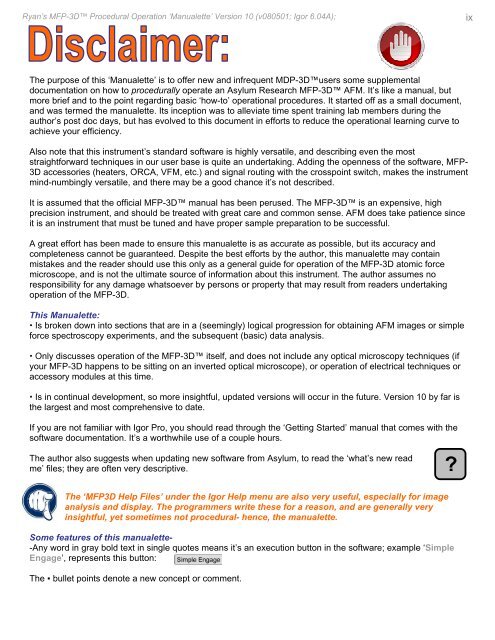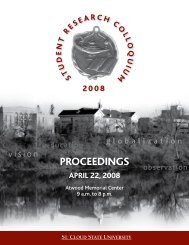B - St. Cloud State University
B - St. Cloud State University
B - St. Cloud State University
You also want an ePaper? Increase the reach of your titles
YUMPU automatically turns print PDFs into web optimized ePapers that Google loves.
Ryan’s MFP-3D Procedural Operation ‘Manualette’ Version 10 (v080501; Igor 6.04A);<br />
ix<br />
The purpose of this ‘Manualette’ is to offer new and infrequent MDP-3Dusers some supplemental<br />
documentation on how to procedurally operate an Asylum Research MFP-3D AFM. It’s like a manual, but<br />
more brief and to the point regarding basic ‘how-to’ operational procedures. It started off as a small document,<br />
and was termed the manualette. Its inception was to alleviate time spent training lab members during the<br />
author’s post doc days, but has evolved to this document in efforts to reduce the operational learning curve to<br />
achieve your efficiency.<br />
Also note that this instrument’s standard software is highly versatile, and describing even the most<br />
straightforward techniques in our user base is quite an undertaking. Adding the openness of the software, MFP-<br />
3D accessories (heaters, ORCA, VFM, etc.) and signal routing with the crosspoint switch, makes the instrument<br />
mind-numbingly versatile, and there may be a good chance it’s not described.<br />
It is assumed that the official MFP-3D manual has been perused. The MFP-3D is an expensive, high<br />
precision instrument, and should be treated with great care and common sense. AFM does take patience since<br />
it is an instrument that must be tuned and have proper sample preparation to be successful.<br />
A great effort has been made to ensure this manualette is as accurate as possible, but its accuracy and<br />
completeness cannot be guaranteed. Despite the best efforts by the author, this manualette may contain<br />
mistakes and the reader should use this only as a general guide for operation of the MFP-3D atomic force<br />
microscope, and is not the ultimate source of information about this instrument. The author assumes no<br />
responsibility for any damage whatsoever by persons or property that may result from readers undertaking<br />
operation of the MFP-3D.<br />
This Manualette:<br />
• Is broken down into sections that are in a (seemingly) logical progression for obtaining AFM images or simple<br />
force spectroscopy experiments, and the subsequent (basic) data analysis.<br />
• Only discusses operation of the MFP-3D itself, and does not include any optical microscopy techniques (if<br />
your MFP-3D happens to be sitting on an inverted optical microscope), or operation of electrical techniques or<br />
accessory modules at this time.<br />
• Is in continual development, so more insightful, updated versions will occur in the future. Version 10 by far is<br />
the largest and most comprehensive to date.<br />
If you are not familiar with Igor Pro, you should read through the ‘Getting <strong>St</strong>arted’ manual that comes with the<br />
software documentation. It’s a worthwhile use of a couple hours.<br />
The author also suggests when updating new software from Asylum, to read the ‘what’s new read<br />
me’ files; they are often very descriptive.<br />
The ‘MFP3D Help Files’ under the Igor Help menu are also very useful, especially for image<br />
analysis and display. The programmers write these for a reason, and are generally very<br />
insightful, yet sometimes not procedural- hence, the manualette.<br />
Some features of this manualette-<br />
-Any word in gray bold text in single quotes means it’s an execution button in the software; example ‘Simple<br />
Engage’, represents this button:<br />
The ▪ bullet points denote a new concept or comment.<br />
?
















